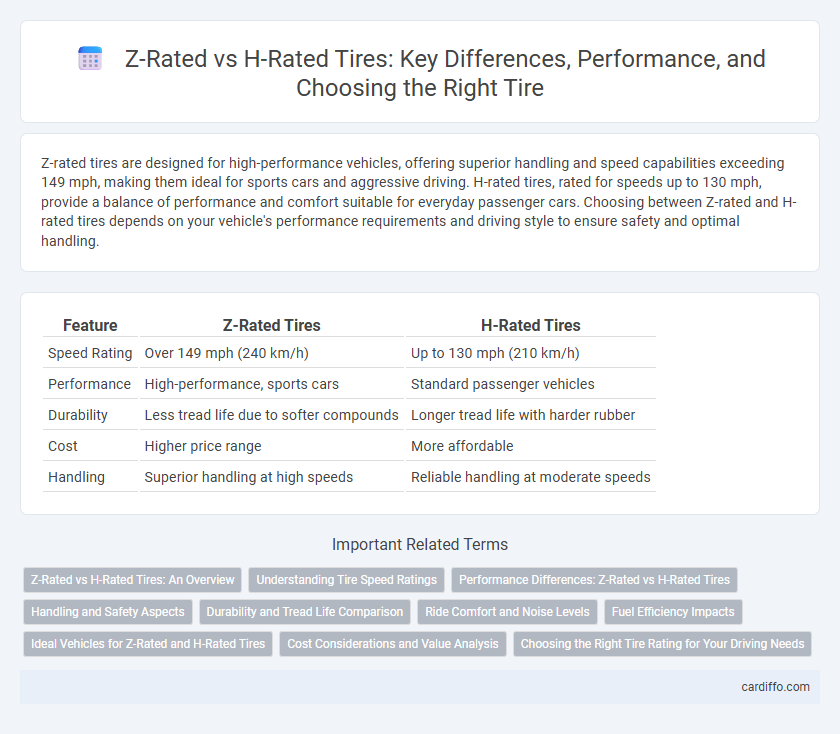Z-rated tires are designed for high-performance vehicles, offering superior handling and speed capabilities exceeding 149 mph, making them ideal for sports cars and aggressive driving. H-rated tires, rated for speeds up to 130 mph, provide a balance of performance and comfort suitable for everyday passenger cars. Choosing between Z-rated and H-rated tires depends on your vehicle's performance requirements and driving style to ensure safety and optimal handling.
Table of Comparison
| Feature | Z-Rated Tires | H-Rated Tires |
|---|---|---|
| Speed Rating | Over 149 mph (240 km/h) | Up to 130 mph (210 km/h) |
| Performance | High-performance, sports cars | Standard passenger vehicles |
| Durability | Less tread life due to softer compounds | Longer tread life with harder rubber |
| Cost | Higher price range | More affordable |
| Handling | Superior handling at high speeds | Reliable handling at moderate speeds |
Z-Rated vs H-Rated Tires: An Overview
Z-rated tires are designed for high-performance vehicles, capable of speeds over 149 mph (240 km/h), offering enhanced grip and stability at extreme speeds. H-rated tires support speeds up to 130 mph (210 km/h), providing reliable performance for everyday driving with a balance of comfort and durability. Choosing between Z-rated and H-rated tires depends on vehicle requirements and driving conditions, with Z-rated prioritized for sports cars and H-rated optimal for standard vehicles.
Understanding Tire Speed Ratings
Z-rated tires are designed for speeds exceeding 149 mph (240 km/h), making them suitable for high-performance vehicles requiring enhanced handling and stability at extreme speeds. H-rated tires are rated for a maximum speed of 130 mph (210 km/h), commonly found on standard passenger cars, providing a balance of comfort and safety. Understanding tire speed ratings ensures optimal tire selection based on vehicle capabilities and driving conditions, enhancing safety and performance.
Performance Differences: Z-Rated vs H-Rated Tires
Z-rated tires are designed for high-performance vehicles, offering superior speed capabilities exceeding 149 mph, enhanced grip, and improved handling at high speeds compared to H-rated tires, which are rated for speeds up to 130 mph. The construction of Z-rated tires typically includes advanced rubber compounds and reinforced sidewalls, resulting in better traction and cornering stability under extreme driving conditions. H-rated tires prioritize comfort and durability for everyday driving with moderate speed limits, making them suitable for standard passenger cars but less effective in dynamic driving scenarios.
Handling and Safety Aspects
Z-rated tires provide superior handling performance and enhanced safety at speeds over 149 mph due to their advanced rubber compounds and reinforced sidewalls, offering better grip and stability during high-speed maneuvers. H-rated tires, designed for speeds up to 130 mph, prioritize comfort and long tread life but deliver less aggressive handling and reduced performance in extreme driving conditions. Choosing Z-rated tires improves braking response and cornering precision, crucial for high-speed driving safety, whereas H-rated tires are suitable for everyday use with moderate speed requirements.
Durability and Tread Life Comparison
Z-rated tires typically offer superior durability and longer tread life compared to H-rated tires due to their high-performance rubber compounds and reinforced sidewalls designed for increased stress resistance. The advanced materials and construction methods in Z-rated tires enhance resistance to wear and heat buildup, resulting in extended tread life under aggressive driving conditions. In contrast, H-rated tires, tailored for moderate speeds, generally provide adequate durability but may wear out faster on high-performance or heavy-load applications.
Ride Comfort and Noise Levels
Z-rated tires, designed for high-speed performance above 149 mph, feature stiffer sidewalls and sportier tread patterns that often result in a firmer ride and increased road noise. In contrast, H-rated tires, rated for speeds up to 130 mph, typically incorporate softer compounds and more comfort-oriented tread designs, delivering a smoother ride with reduced noise levels. Drivers prioritizing ride comfort and quietness usually prefer H-rated tires over Z-rated ones, especially for daily commuting and long-distance driving.
Fuel Efficiency Impacts
Z-rated tires, designed for high-speed performance exceeding 149 mph, typically feature softer rubber compounds and aggressive tread patterns that can increase rolling resistance, leading to lower fuel efficiency compared to H-rated tires. H-rated tires, rated for speeds up to 130 mph, often incorporate harder compounds and optimized tread designs aimed at reducing rolling resistance, thus enhancing fuel economy. Selecting H-rated tires can result in measurable fuel savings, especially for everyday driving conditions where high-speed capability is unnecessary.
Ideal Vehicles for Z-Rated and H-Rated Tires
Z-rated tires are ideal for high-performance sports cars and luxury vehicles requiring speeds over 149 mph, offering enhanced handling and stability at high velocities. H-rated tires suit mid-sized sedans and family cars designed for speeds up to 130 mph, providing reliable traction and comfort for everyday driving. Selecting tires based on speed ratings ensures optimal safety and performance tailored to the vehicle's capabilities.
Cost Considerations and Value Analysis
Z-rated tires, designed for speeds over 149 mph, generally come with a higher price tag due to superior performance materials and advanced tread technology compared to H-rated tires, which are rated for speeds up to 130 mph. The cost difference reflects enhanced durability, grip, and handling capabilities, making Z-rated tires a preferred choice for high-performance vehicles despite their premium cost. Evaluating the value, Z-rated tires offer long-term benefits in safety and performance for speed enthusiasts, while H-rated tires provide a more economical option for everyday driving with adequate safety and reliability.
Choosing the Right Tire Rating for Your Driving Needs
Z-rated tires offer superior speed capabilities exceeding 149 mph, making them ideal for high-performance vehicles and spirited driving. H-rated tires, designed for speeds up to 130 mph, provide a balanced combination of safety, comfort, and durability suitable for everyday commuting and family sedans. Selecting the appropriate tire rating ensures optimal performance, handling, and safety based on your vehicle type and driving conditions.
Z-rated tires vs H-rated tires Infographic

 cardiffo.com
cardiffo.com